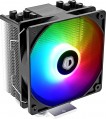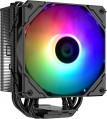Max. TDP
The maximum TDP provided by the cooling system. Note that this parameter is indicated only for solutions equipped with heatsinks (see "Type"); for separately made fans, the efficiency is determined by other parameters, primarily by the air flow values (see above).
TDP can be described as the amount of heat that a cooling system is able to remove from a serviced component. Accordingly, for the normal operation of the entire system, it is necessary that the TDP of the cooling system is not lower than the heat dissipation of this component (heat dissipation data is usually indicated in the detailed characteristics of the components). And it is best to select coolers with a power margin of at least 20 – 25% — this will give an additional guarantee in case of forced operation modes and emergency situations (including clogging of the case and reduced air exchange efficiency).
As for specific numbers, the most modest modern cooling systems provide TDP
up to 100 W, the most advanced —
up to 250 W and even
higher.
Min. RPM
The lowest speed at which the cooling fan is capable of operating. Specified only for models with speed control (see below).
The lower the minimum speed (with the same maximum) — the wider the speed control range and the more you can slow down the fan when high performance is not needed (such a slowdown allows you to reduce energy consumption and noise level). On the other hand, an extensive range affects the cost accordingly.
Max. air flow
The maximum airflow that a cooling fan can create; measured in CFM — cubic feet per minute.
The higher the CFM number, the more efficient the fan. On the other hand, high performance requires either a large diameter (which affects the size and cost) or high speed (which increases the noise and vibration levels). Therefore, when choosing, it makes sense not to chase the maximum air flow, but to use special formulas that allow you to calculate the required number of CFM depending on the type and power of the cooled component and other parameters. Such formulas can be found in special sources. As for specific numbers, in the most modest systems, the performance
does not exceed 30 CFM, and in the most powerful systems it can be up to 80 CFM and even
more.
It is also worth considering that the actual value of the air flow at the highest speed is usually lower than the claimed maximum; see Static Pressure for details.
Static pressure
The maximum static air pressure generated by the fan during operation.
This parameter is measured as follows: if the fan is installed on a blind pipe, from which there is no air outlet, and turned on for blowing, then the pressure reached in the pipe will correspond to the static one. In fact, this parameter determines the overall efficiency of the fan: the higher the static pressure (ceteris paribus), the easier it is for the fan to “push” the required amount of air through a space with high resistance, for example, through narrow slots of a radiator or through a case full of components.
Also, this parameter is used for some specific calculations, however, these calculations are quite complex and, usually, are not necessary for an ordinary user — they are associated with nuances that are relevant mainly for computer enthusiasts. You can read more about this in special sources.
Noise level
The standard noise level generated by the cooling system during operation. Usually, this paragraph indicates the maximum noise during normal operation, without overloads and other "extreme".
Note that the noise level is indicated in decibels, and this is a non-linear value. So it is easiest to evaluate the actual loudness using comparative tables. Here is a table for values found in modern cooling systems:
20 dB — barely audible sound (quiet whisper of a person at a distance of about 1 m, sound background in an open field outside the city in calm weather);
25 dB — very quiet (normal whisper at a distance of 1 m);
30 dB — quiet (wall clock). It is this noise that, according to sanitary standards, is the maximum allowable for constant sound sources at night (from 23.00 to 07.00). This means that if the computer is planned to sit at night, it is desirable that the volume of the cooling system does not exceed this value.
35 dB — conversation in an undertone, sound background in a quiet library;
40 dB — conversation, relatively quiet, but already in full voice. The maximum permissible noise level for residential premises in the daytime, from 7.00 to 23.00, according to sanitary standards. However, even the noisiest cooling systems usually do not reach this indicator, the maximum for such equipment is about 38 – 39 dB.
LED power supply
The type of power connector for the backlight system. The following interfaces are most often used for these purposes:
— 3-pin (5V). Three-pin connector with a working voltage of 5 V. It is supposed to supply power to the corresponding decorative lighting systems.
— 4-pin (12V). The four-pin connector can supply 12-volt power to operate the backlight.
— iCUE LINK. A proprietary connector from Corsair that allows you to synchronize the backlight and control the cooling system fans. For flexible adjustment of backlight effects and fan speed, use the proprietary Corsair iCUE software.
Dimensions
General dimensions of the cooling system. For water systems (see "Type"), this paragraph indicates the size of the external radiator (the dimensions of the water block in such devices are small, and there is no need to specify them in particular).
In general, this is a fairly obvious parameter. We only note that for case fans (see ibid.), the thickness is of particular importance — it directly depends on how much space the device will take up inside the system unit. At the same time, it is customary to refer to
fans with a thin case for models in which this size does not exceed 20 mm.
Height
The cooling system should fit into the computer case without any problems. The vast majority of case manufacturers indicate in the specifications the maximum height of the cooler that can be installed on their chassis. It is from this value that it is necessary to build on when choosing a cooling system. With an oversized cooler, you will have to leave the side wall of the case wide open, which violates the built-in air circulation pattern and provokes dust pollution of the internal space of the system unit.

